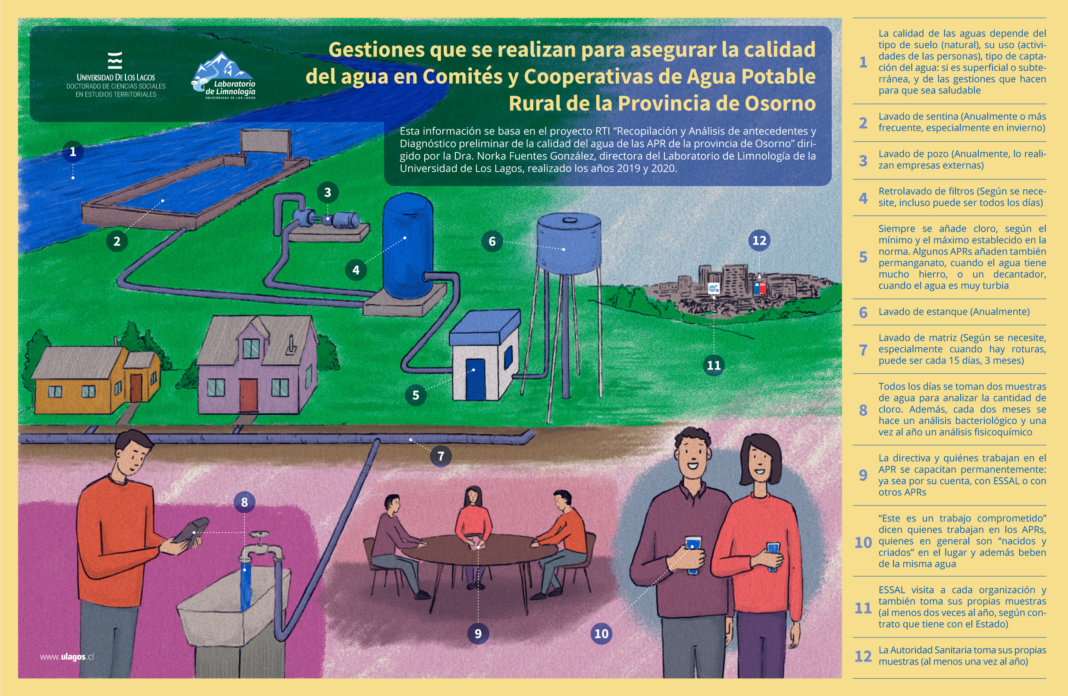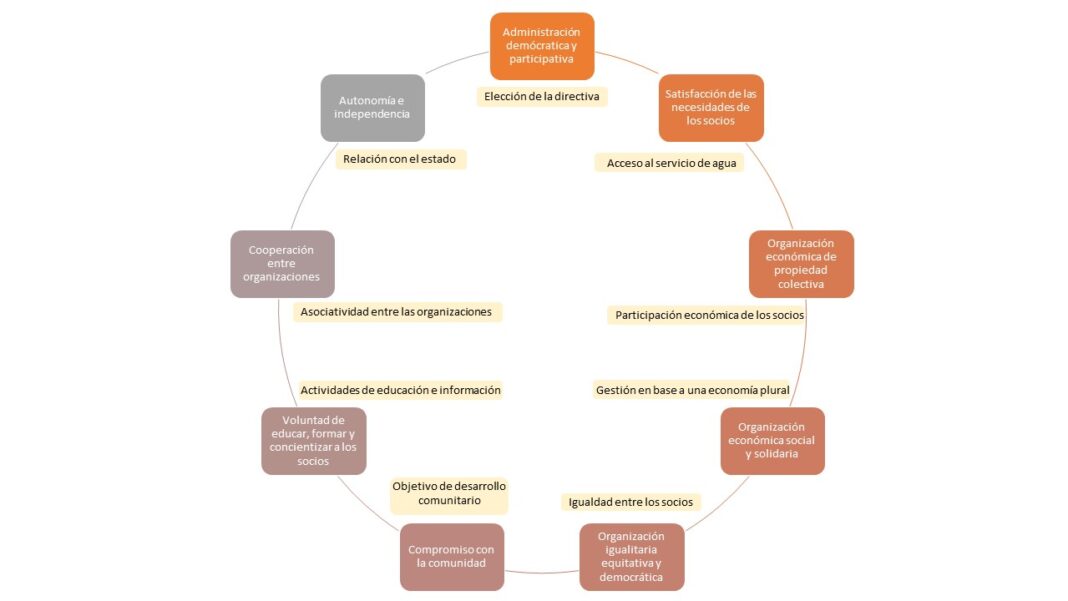- These groups play a relevant role at the rural level, since their actions are based on the principles of a social and solidarity economy, and they guarantee equitable access to water.
- New regulations seek to regularize the sector, but in a way that is not adequate to its reality, since it does not protect the social and community ties of these organizations.
- Both in the Water Code and in the draft of the New Constitution, water is being proposed as a common good, a vision that these organizations already have, for which reason they should be strengthened and included in the decision-making processes.
By Chloé Nicolas-Artero, Noelia Carrasco Henríquez, Claudio Pareja, Jeannette Calvet Tapia and Gustavo Blanco.
Go to Recommendations
In Chile, obtaining tap water in rural homes rarely depends on a private sanitation company as in the case of cities, but instead depends on the daily effort of people involved in neighborhood associations, committees, or rural drinking water cooperatives. Thus, these community organizations play a fundamental role in responding to the demand for water for human consumption of approximately 10% of the country’s inhabitants.
The distribution service that they carry out starts from the place where the water is collected up to the home connection, and to manage it they implement a community management based on democratic principles that does not pursue profit.
Until now, the scale of intervention of these organizations is densely populated rural localities, but that do not coincide with the territorial limits of the basins. Due to this, and considering the climate change context, these organizations should be protagonists of the so-called integrated watershed management, an instrument that could be applied in the future with the implementation of the Climate Change Law or the new constitutional text. What is meant by this type of management? It is the coordination of the use and management of water to guarantee the well-being of the population and economic activities using the hydrographic basins as the base territory (Dourojeanni et al., 2002; Azócar et al., 2022), which are the terrestrial surfaces on which all water flows circulate in the same direction: a water course or the sea.
Community water management: A social economy
Community drinking water organizations are formed in response to the need of a group of neighbors to have a home connection to water, meeting to install networks and manage the service in a self-financing manner. In 1964, with international aid, the Rural Drinking Water Program was created, implemented by the Ministry of Public Works, which consisted of financing basic infrastructures and ceding the administration of the service to the beneficiary inhabitants, grouped into associations with legal personality. This is how the rural drinking water committees and cooperatives were born, which were governed by the Neighborhood Council Law and the Cooperatives Law, respectively, and which, currently, adhere to Law 20,998 on Rural Sanitation Services.
Both in the past and in the present, when the groups are not regularized (by the program or the law), they request support from the municipalities, from where resources are managed in the Regional Government, or from the Undersecretariat for Regional and Administrative Development. (Subdere). The degree of formalization of organizations that do not receive state support depends on the will of their members. By the year 2022, it is estimated that there are 1,962 organizations associated with the Program and 315 non-affiliated (CR2 Database).
Despite the technical diversity in the process of collecting and delivering water (Figure 1), the organizations implement community management whose actions reflect the principles of a social and solidarity economy (Coraggio, 2012). This consists of implementing a democratic management through the election of a board of directors and the economic participation of the partners through an incorporation fee that respects equality criteria. In addition to guaranteeing equitable access to water, the objective of many organizations is to support the social development of the community through different interventions and promoting environmental education (Figure 2). Depending on its degree of formality, the board of directors must also learn and implement the labor, tax, subsidy, and sanitary laws, the specific ones on rural drinking water, and the Water Code.

The organizations have their own resources generated thanks to the fee they collect monthly. A fixed charge is usually distinguished to which consumption is added, the price of which increases per link proportionally to it. Income and delinquency levels vary depending on the number of partners, their financial capacity, and their level of consumption. Although the State supports the allocation of subsidies for water consumption, these are delivered at the wrong time, creating management difficulties and do not apply to informal organizations. To varying degrees, depending on the size and focus of the organization, the water tariff makes it possible to finance the remuneration of workers, the maintenance costs of the network and even its expansion. However, there are no specific public funds earmarked for all organizations to promote their development or internal strengthening.

Regulations that do not consider the social dimension
The rural population is the first and main victim of water scarcity (Fragkou et al., 2022). Wells and springs from which water is extracted tend to dry up due to climatic and human factors. For this reason, the leaders of the organizations play a central role in finding solutions to maintain the continuity of the service in complex contexts.
Despite the above, they must deal with increasingly demanding regulations. Part of these come from Law 20,998 on Rural Sanitation Services, approved in 2017 and implemented by the Hydraulic Works Directorate, whose main objective is to regularize the sector and increase sanitation coverage in rural localities. This law proposes various changes, such as the setting of rates by the Superintendency of Sanitation Services (SISS) so that organizations achieve financial autonomy in accordance with criteria established by state entities. It also considers the inclusion of the SISS as a supervisory entity, encouraging them to adhere to manuals created for these purposes and allowing users to make formal claims. This search for professionalization and modernization (Nicolas-Artero, 2016) seems inadequate to rural realities since they do not safeguard the social and community ties that sustain this type of organization.
On the other hand, the reform of the Water Code, and the draft of the new Constitution, propose to respect the human right to water and recognize the latter as a common good that cannot be appropriated.
In rural areas, the responsibility of translating these principles into practice falls on these organizations. Therefore, the strengthening of the understanding of water as a common good with a preferential use for human consumption and not for the generation of economic benefits, implies reflecting on the role of these organizations, their insertion in the basins and in integrated management of them.
A central actor in the basins
Despite the financial autonomy of the organizations, there is a relationship with state and private actors and other users. The link with the State is usually associated with financial support, either for infrastructure or operations through the subsidy for low-income people. Meanwhile, private health companies offer technical and administrative follow-up to the organizations attached to the Program, support that is not exempt from criticism due to its inadaptation to local needs and realities. However, the insufficient or limited presence of the State has led some organizations to build mutual aid networks, creating trade associations at the community, regional or national level. In other cases, it has been observed how private companies in the extractive sectors have offered specific support to organizations as a mitigation policy for the negative externalities produced in their territories.
In recent decades, given the growing drought and the greater use of water by other users, these organizations have had to learn -when they are called- to be part of governance spaces at the level of the hydrographic basins, which are comparable to management. watershed integration. In these new contexts, organizations have begun to work collaboratively with universities or use other forms of articulation in the absence of the State or private pressure. In these spaces, it has also been possible to reveal the power relations that exist at the level of the micro-watersheds supplying the organizations, understood as the land surface on which the water flows feed their catchment point: the water users located downstream above can affect the water supply of the organization. The dumping of sewage from this also affects users located downstream in the basin.
In short, the organizations are central to the management of water resources in the basins due to the responsibility they have assumed to guarantee access to drinking water for the population in the context of mega-drought, their experience in community management of the service, their vision of water as a common good, and its interdependence with users located upstream and downstream in the basin. Therefore, these entities should be protagonists of future integrated basin management instruments.
Recommendations
- Recognize and respect that rural water organizations see water as a common good, ensuring its inclusion and addressing the water crisis collectively. This includes giving spaces of autonomy to each organization and recognizing the principles of the social and solidarity economy in its operation.
- Strengthen the social economy that they represent and recognize the unpaid work of the leaders, stressing the need for state support and payment for a fair water rate.
- Design and implement public support programs for organizations that allow strengthening their modes of management and operation.
- Include organizations in integrated watershed management tools. If you want to privilege the human right to water and the principle of water as a common good, it is important to recognize that this is operationalized, mainly, through these organizations. This includes inviting them, but also facilitating their participation.
- Protect the micro-watersheds that supply these organizations with water. For this, it is crucial to begin to study the hydrogeological processes in which these groups are inserted and to abandon the technical gaze focused mainly on the ever-deeper extraction of groundwater.
References
Azócar, G., Billi, M. & Bórquez, R. (22 marzo 2022). Cuencas hidrográficas: el flujo del agua como delimitación territorial. El Mostrador. https://www.elmostrador.cl/cultura/2022/03/22/cuencas-hidrograficas-el-flujo-del-agua-como-delimitacion-territorial/
Coraggio, J. (2012). Conocimiento y políticas públicas de economía social y solidaria: problemas y propuestas. Editorial IAEN.
Dourojeanni, A., Jouravlev, A.& Chávez, G. (2002). Gestión del agua a nivel de cuencas: teoría y práctica. CEPAL.
Fragkou, M., Monsalve-Tapia, T., Pereira-Roa, V. & Bolados-Arratia, M. (2022). Abastecimiento de agua potable por camiones aljibe durante la megasequía. Un análisis hidrosocial de la provincia de Petorca, Chile. EURE – Revista de Estudios Urbano Regionales, 48(145). 10.7764/EURE.48.145.04
Nicolas-Artero, C. (2016). Las organizaciones comunitarias de agua potable rural en América Latina: un ejemplo de economía substantiva. Polis, 15(45):165-89. 10.4067/S0718-65682016000300009
Pareja, C., Fuentes, N. & Arriagada, A. (2022). Relationships as a Basis for Safe Drinking Water Provision by Cooperatives in Rural Chile. Water, 14(3), 1–15. https://doi.org/10.3390/w14030353





